The Test & Our Results
With the limited game support for the Hydra and our limited time with the new drivers, we’ve had to throw out most of our usual video card testing suite. What we have here are games that are on the approved list and are at least somewhat graphically challenging, but by no means is it a complete list. As FRAPS and the Hydra software do not currently get along, we’re limited to games with built-in frame counters. This is also the reason that we will be doing an in-depth look at the image quality of the Hydra after CES, when we have more time to come up with ways to take screenshots.
Unfortunately our testing today will only paint a limited picture. The Fuzion board does not have SLI support, which means we cannot test a pair of NVIDIA cards in SLI and use that as a baseline for N-Mode performance. We’re hoping to track someone down from MSI here at CES in order to explain why the Fuzion doesn’t have SLI support, as this is a major oversight for a high-end board. Whether NVIDIA was willing or not to license SLI to MSI for the Fuzion is going to be the single biggest question hanging over our heads. Update: We have since received an official response from MSI. They did not implement SLI support as they felt the performance with Hydra was close enough to make SLI support unnecessary. We still find this questionable.
For our performance testing, we used the following games: Call of Juarez (DX10 benchmark), HAWX, Resident Evil 5, Company of Heroes, and Batman: Arkham Asylum. Batman is not supported under X-Mode, so we’ll leave it out of X-Mode testing.
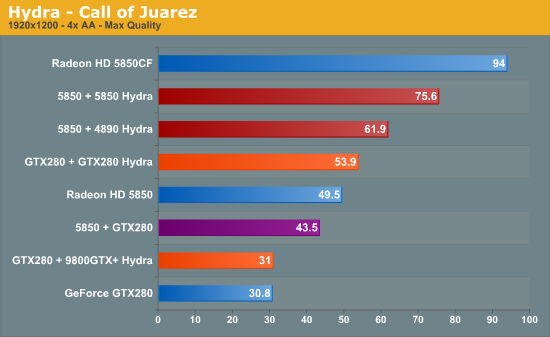
We’ll start with Call of Juarez, which is one of the Hydra’s better titles. With our 5850s in Crossfire, we get 94fps, which is just less than double the performance of a single 5850 (49.5). Right off the bat the Hydra takes a noticeable performance dive when using a pair of 5850s, splitting the difference between 1 and 2 cards with 75.6fps. Certainly it doesn’t look like Hydra can beat SLI/Crossfire, so it shouldn’t come as a surprise that Lucid and MSI aren’t claiming otherwise.
Moving to A-Mode with dissimilar video cards, we get some more definitive good news. Combining a 5850 and a 4890 gets us 61.9fps, a 25% performance improvement. This is less than the raw power of the 4890 (which is to say, in a perfect situation the 4890 performs at well more than 25% of a 5850) but it’s solid proof that this works.
As for the NVIDIA side, since we don’t have SLI results we’ll have to look at single-card and Hydra results. While 1 GTX280 gives us 30.8fps, a pair of them in N-Mode gives us 53.9, a 75% increase. This is much better than the increase we got on the 5850s, and much closer to the 100% theoretical max that we expect SLI is close to.
Switching to a GTX280 + 9800GTX+, things aren’t so rosy. The performance difference is practically absent at 0.2fps. While the Hydra technology scales worse the more mismatched a set of cards are, this is particularly awful.
Finally we have X-Mode using a 5850 + GTX280, with the AMD card as the master card. Here we get 43.5fps, which is slower than a single 5850. During this time we got significant microstuttering and striping in the image. Our best guess is that the Hydra was having trouble in the compositing phase, as the striping is a product of that. However in A-Mode and N-Mode we encountered no such issues. To the naked eye, Call of Juarez looked just as good in A-Mode and N-Mode as it does on a single video card.
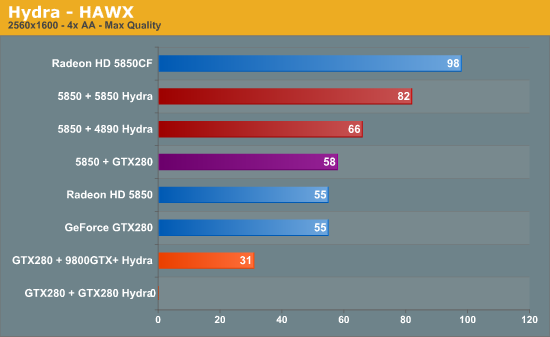
Moving to our old standby of HAWX, the picture is similar. Hydra performance on the 5850s is still below CF, but it’s still a 50% improvement. 5850 + 4890 is a 20% performance improvement. The GTX280s weren’t quite a success story however – HAWX crashed with a Lucid driver error when attempting to load the main menu of HAWX. Strangely the GTX280 + 9800GTX+ had no launch issues, rather the combination significantly underperformed the single GTX280 at -56%. Finally the 5850 + GTX280 came in at 58fps, which at a few fps faster than the lone 5850 is less than flattering.
Besides the single crash at no point did we see evidence of graphical corruption. HAWX always rendered correctly, even in X-Mode.
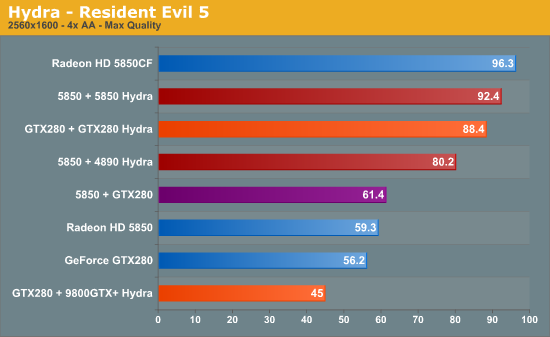
Resident Evil 5, in spite of being on the approved game list, was problematic for all Hydra modes. Every mode suffered from the same flickering problem (we suspect it’s lighting related), which doesn’t make the game unplayable but does make it annoying to play.
The performance however was very, very good. The 5850s got within 4% of CF mode, and the 5850 + 4890 still offered a solid 33% performance boost. The GTX280s did 57% better than a single GTX280, and the GTX280 + 9800GTX+ was the odd man out by losing performance. In X-Mode, the 5850 + GTX280 managed to squeak ahead of the single 5850 by 3.5%.
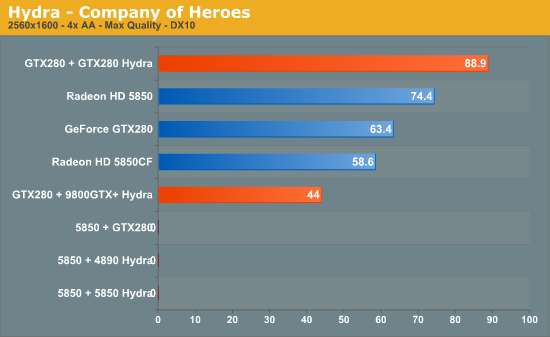
Company of Heroes is another game on the supported list that we didn’t have much luck with. There was no graphical corruption this time around, but instead it crashed on every mode involving an AMD card.
As for the NVIDIA cards, the GTX280s picked up about 30%, and the GTX280 + 9800GTX+ lost nearly the same 30%. There was no graphical corruption to report.
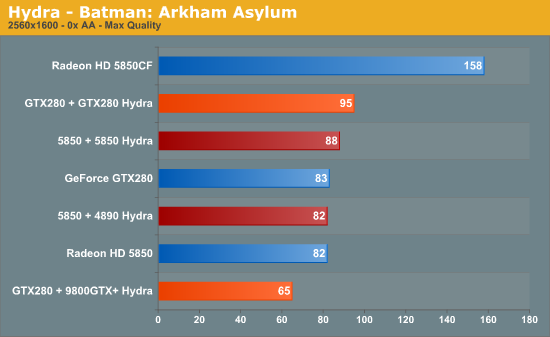
Finally we have Batman: Arkham Asylum, one of the most popular games of 2009. It doesn’t work in X-Mode, but does in N-Mode and A-Mode.
Unfortunately for the AMD cards, Lucid is having some scaling issues in A-Mode, something they do note in their release notes. A pair of 5850s is barely better than a single 5850, and a 5850 + 4890 flat-out isn’t better. The GTX280s pick up 15%, and the GTX280 + 9800GTX+ loses over 20%.
Frankly our testing experience was a mix of failures and successes, and this was sticking to the approved games list. Not a single game we picked to test worked perfectly in all cases, and the 1.4 driver release notes are a minefield of known issues. And unlike NVIDIA/AMD’s known issues, which tend to affect esoteric hardware and games, these are issues on what would be reasonably common high-end hardware configurations with popular games.
Here is by no means a complete list of games with known issues of graphical corruption: Call of Duty 4, World in Conflict (DX10), Rainbow Six Vegas 2, Operation Flashpoint Dragon Rising, Resident Evil 5. And as we’ve seen, this doesn’t include crashes, or undocumented graphical corruption.
We held off in doing significant testing on our Fuzion board until we had the 1.4 drivers in order to give Lucid time to get their next driver set out, since that set would be available when the hardware shipped. It was our hope in that moving from the 1.3 to 1.4 drivers that we’d see a reduction in graphical corruption compared to our tests in December when Lucid and MSI sent reps out, but that has not been the case.
This is by no means a complete list, and we aren’t going to claim otherwise. But in our testing thus-far, the Hydra drivers clearly need much more work. Frankly, we hesitate to think about what might have happened if the Fuzion shipped in November as originally announced.










47 Comments
View All Comments
ExarKun333 - Thursday, January 7, 2010 - link
Performance seems a little weak; hopefully driver fixes will increase trhe scaling. If it can't meet SLI/CF specs, it probably won't survive. Less scaling in "X" mode is acceptable, but you would still hope for decent performance gains with mis-matched cards.Zstream - Thursday, January 7, 2010 - link
Please!!!!!!!!!!!!!!!!!!!!!!!!!!!!!!!!!!!!!!!!!!I could care least if CF/SLI achieves 100FPS average when it dips down to 15FPS.
Mr Perfect - Thursday, January 7, 2010 - link
He's absolutely right.When buying a video card I'm not worried about the highest frame rate peak, or even the average framerate, I'm trying to avoid the dreaded minimum FPS slideshow. If a card spends half of it's time doing 100FPS, and the other half at 15FPS, I'd rather buy the card the does a steady 50FPS.
StraightPipe - Thursday, January 7, 2010 - link
The article clearly stated that FRAPS doesnt work, and they are just grabbing FPS off the screen. Not very accurate or reliable, but it's better than nothing.Here's to hoping that we'll get some more detail about MIN FPS in Part2.
jnmfox - Thursday, January 7, 2010 - link
QFTGeorgeH - Thursday, January 7, 2010 - link
I agree, the minimum frame rate is very important here, especially in X mode. I understand it might not be possible without better support for games and benchmarking tools, but if you can find a way please do so.AmbroseAthan - Thursday, January 7, 2010 - link
Do the Hydra drivers allow for Folding@Home to be run, or is it another sacrifice for using Hydra?I have hopes Lucid can get Hydra up and running pretty solidly, as the concept is wonderful. But it does seem multiple reviews right now are finding a lot of issues with the drivers.